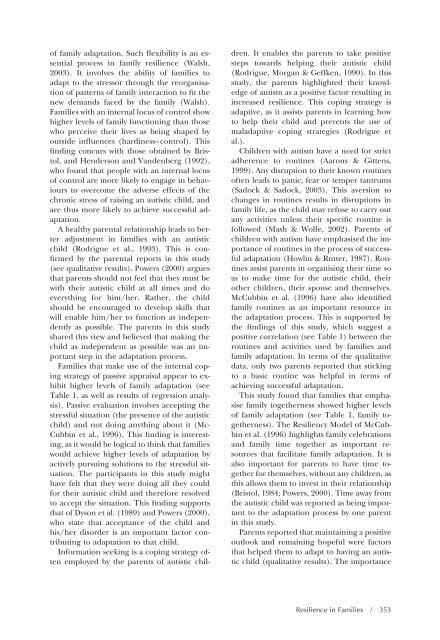Education and Training in Autism and Developmental Disabilities
Education and Training in Autism and Developmental Disabilities
Education and Training in Autism and Developmental Disabilities
You also want an ePaper? Increase the reach of your titles
YUMPU automatically turns print PDFs into web optimized ePapers that Google loves.
of family adaptation. Such flexibility is an essential<br />
process <strong>in</strong> family resilience (Walsh,<br />
2003). It <strong>in</strong>volves the ability of families to<br />
adapt to the stressor through the reorganisation<br />
of patterns of family <strong>in</strong>teraction to fit the<br />
new dem<strong>and</strong>s faced by the family (Walsh).<br />
Families with an <strong>in</strong>ternal locus of control show<br />
higher levels of family function<strong>in</strong>g than those<br />
who perceive their lives as be<strong>in</strong>g shaped by<br />
outside <strong>in</strong>fluences (hard<strong>in</strong>ess–control). This<br />
f<strong>in</strong>d<strong>in</strong>g concurs with those obta<strong>in</strong>ed by Bristol,<br />
<strong>and</strong> Henderson <strong>and</strong> V<strong>and</strong>enberg (1992),<br />
who found that people with an <strong>in</strong>ternal locus<br />
of control are more likely to engage <strong>in</strong> behaviours<br />
to overcome the adverse effects of the<br />
chronic stress of rais<strong>in</strong>g an autistic child, <strong>and</strong><br />
are thus more likely to achieve successful adaptation.<br />
A healthy parental relationship leads to better<br />
adjustment <strong>in</strong> families with an autistic<br />
child (Rodrigue et al., 1993). This is confirmed<br />
by the parental reports <strong>in</strong> this study<br />
(see qualitative results). Powers (2000) argues<br />
that parents should not feel that they must be<br />
with their autistic child at all times <strong>and</strong> do<br />
everyth<strong>in</strong>g for him/her. Rather, the child<br />
should be encouraged to develop skills that<br />
will enable him/her to function as <strong>in</strong>dependently<br />
as possible. The parents <strong>in</strong> this study<br />
shared this view <strong>and</strong> believed that mak<strong>in</strong>g the<br />
child as <strong>in</strong>dependent as possible was an important<br />
step <strong>in</strong> the adaptation process.<br />
Families that make use of the <strong>in</strong>ternal cop<strong>in</strong>g<br />
strategy of passive appraisal appear to exhibit<br />
higher levels of family adaptation (see<br />
Table 1, as well as results of regression analysis).<br />
Passive evaluation <strong>in</strong>volves accept<strong>in</strong>g the<br />
stressful situation (the presence of the autistic<br />
child) <strong>and</strong> not do<strong>in</strong>g anyth<strong>in</strong>g about it (Mc-<br />
Cubb<strong>in</strong> et al., 1996). This f<strong>in</strong>d<strong>in</strong>g is <strong>in</strong>terest<strong>in</strong>g,<br />
as it would be logical to th<strong>in</strong>k that families<br />
would achieve higher levels of adaptation by<br />
actively pursu<strong>in</strong>g solutions to the stressful situation.<br />
The participants <strong>in</strong> this study might<br />
have felt that they were do<strong>in</strong>g all they could<br />
for their autistic child <strong>and</strong> therefore resolved<br />
to accept the situation. This f<strong>in</strong>d<strong>in</strong>g supports<br />
that of Dyson et al. (1989) <strong>and</strong> Powers (2000),<br />
who state that acceptance of the child <strong>and</strong><br />
his/her disorder is an important factor contribut<strong>in</strong>g<br />
to adaptation to that child.<br />
Information seek<strong>in</strong>g is a cop<strong>in</strong>g strategy often<br />
employed by the parents of autistic chil-<br />
dren. It enables the parents to take positive<br />
steps towards help<strong>in</strong>g their autistic child<br />
(Rodrigue, Morgan & Geffken, 1990). In this<br />
study, the parents highlighted their knowledge<br />
of autism as a positive factor result<strong>in</strong>g <strong>in</strong><br />
<strong>in</strong>creased resilience. This cop<strong>in</strong>g strategy is<br />
adaptive, as it assists parents <strong>in</strong> learn<strong>in</strong>g how<br />
to help their child <strong>and</strong> prevents the use of<br />
maladaptive cop<strong>in</strong>g strategies (Rodrigue et<br />
al.).<br />
Children with autism have a need for strict<br />
adherence to rout<strong>in</strong>es (Aarons & Gittens,<br />
1999). Any disruption to their known rout<strong>in</strong>es<br />
often leads to panic, fear or temper tantrums<br />
(Sadock & Sadock, 2003). This aversion to<br />
changes <strong>in</strong> rout<strong>in</strong>es results <strong>in</strong> disruptions <strong>in</strong><br />
family life, as the child may refuse to carry out<br />
any activities unless their specific rout<strong>in</strong>e is<br />
followed (Mash & Wolfe, 2002). Parents of<br />
children with autism have emphasised the importance<br />
of rout<strong>in</strong>es <strong>in</strong> the process of successful<br />
adaptation (Howl<strong>in</strong> & Rutter, 1987). Rout<strong>in</strong>es<br />
assist parents <strong>in</strong> organis<strong>in</strong>g their time so<br />
as to make time for the autistic child, their<br />
other children, their spouse <strong>and</strong> themselves.<br />
McCubb<strong>in</strong> et al. (1996) have also identified<br />
family rout<strong>in</strong>es as an important resource <strong>in</strong><br />
the adaptation process. This is supported by<br />
the f<strong>in</strong>d<strong>in</strong>gs of this study, which suggest a<br />
positive correlation (see Table 1) between the<br />
rout<strong>in</strong>es <strong>and</strong> activities used by families <strong>and</strong><br />
family adaptation. In terms of the qualitative<br />
data, only two parents reported that stick<strong>in</strong>g<br />
to a basic rout<strong>in</strong>e was helpful <strong>in</strong> terms of<br />
achiev<strong>in</strong>g successful adaptation.<br />
This study found that families that emphasise<br />
family togetherness showed higher levels<br />
of family adaptation (see Table 1, family togetherness).<br />
The Resiliency Model of McCubb<strong>in</strong><br />
et al. (1996) highlights family celebrations<br />
<strong>and</strong> family time together as important resources<br />
that facilitate family adaptation. It is<br />
also important for parents to have time together<br />
for themselves, without any children, as<br />
this allows them to <strong>in</strong>vest <strong>in</strong> their relationship<br />
(Bristol, 1984; Powers, 2000). Time away from<br />
the autistic child was reported as be<strong>in</strong>g important<br />
to the adaptation process by one parent<br />
<strong>in</strong> this study.<br />
Parents reported that ma<strong>in</strong>ta<strong>in</strong><strong>in</strong>g a positive<br />
outlook <strong>and</strong> rema<strong>in</strong><strong>in</strong>g hopeful were factors<br />
that helped them to adapt to hav<strong>in</strong>g an autistic<br />
child (qualitative results). The importance<br />
Resilience <strong>in</strong> Families / 353

















